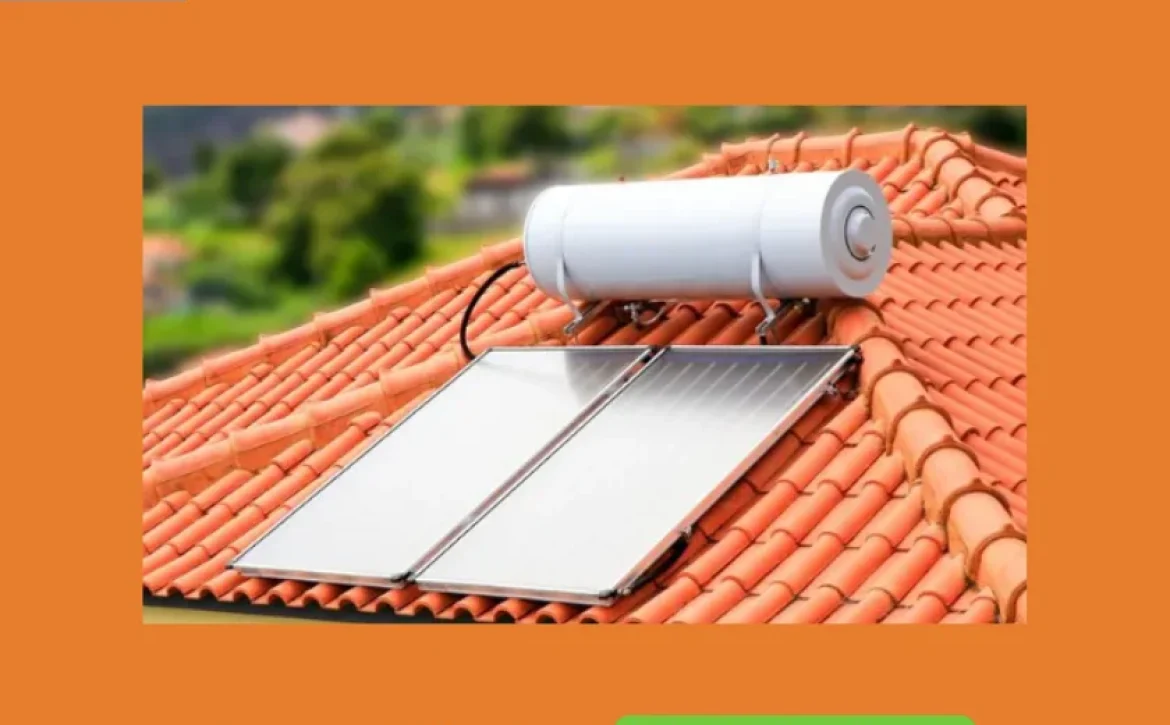Common FAQ’s About Solar Water Heater
A solar water heating system is a device that uses the sunlight to heat water. The Sun’s rays hit the collector panel (a component of the solar water heating system). A black absorbing surface (absorber) within the collectors absorbs solar radiation and transmits the thermal energy to the water that flows through it.
How Does A Solar Water Heater Work?
Heated water is stored in an insulated tank to avoid heat loss. The thermal siphon system ensures that water circulates automatically from the tank to the collectors and back to the tank.
Water is easily heated to temperatures ranging from 60 to 80 degrees Celsius. Solar water heaters with capacity ranging from 100 to 300 liters are suitable for domestic use, and larger systems will be required for establishments with a higher demand for power. A 100-liter SWH can replace an electric geyser for domestic usage and save around 1500 units of electricity per year.
How to Build A Solar Water Heater?
Here’s how you can build your own solar water heater with 4×4’ sheet of plywood, three 2x2x8’ lumber, and 200 ft of tubing.
- Measure the precise perimeter measurements of your plywood and cut them one at a time. Position each piece and re-measure for the following cut.
- After cutting the pieces, hammer or screw them to the plywood to form a frame.
- Now, insert a little piece of extra wood below one piece diagonally. This will keep the 1/2″ tubing in place much more successfully.
- After installing the diagonal piece, drill a series of pairs of holes (about an inch apart) in the plywood, fairly randomly. These holes are used to thread zip ties and secure the tubing to the board.
- Start creating the coil with the tubing. Begin in the center, and work your way out. The extra 5 feet should rest on top of the coil and ultimately emerge from the left side of the frame (this is the intake, where cool water enters the coil).
- Continue coiling below this intake piece, use zip ties to secure the tubing wherever possible. Continue coiling (you should probably use all 200 feet of tubing), leaving another 5 feet of tubing at the end to peek out of the right side of the frame (this is where the newly warmed water will exit the coil and enter the pool).
- If the coil seems loose somewhere, try adding extra zip ties. If you have to drill more holes, be very careful not to rupture the tubing.
- Cut tiny 1″ holes at either end of the frame to accommodate the tubing’s intake and exit sides. Drill extra holes in the plywood and secure the tubing with more zip ties. Now the solar collector is ready.
- Attach the 1/2 tube-to-3/4″ garden hose adapters to both ends of the irrigation tubing, preferably with some black electrical tape.
- Determine where you want to place the solar thermal collector coil (where it will receive the most sunlight throughout the day) and then select pipes that will extend from the left side of the collector to the water tank (or even a pool of water).
- On the left side, connect the other end of the hose to your submersible utility pump. Tie a rope to the pump so you can lower/raise it into the water tank.
- Now wait for a bright day, let the coil heat up somewhat, and then plug it in, and enjoy hot water free of cost.
What Is A Solar Water Heater?
Solar water heaters, also known as solar domestic hot water systems, can be an affordable solution to provide hot water for your house. They may be utilized in any environment, and their fuel (sunlight) is absolutely free.
Two main components of solar water heating systems are solar collectors and storage tanks. Solar water heating systems come in two types classified as active or passive. Active systems contain circulating pumps and controllers, whilst passive ones do not.
How Does A Solar Hot Water Heater Work?
Solar water heaters (also known as solar hot water) are an alternative to traditional water heating systems which run on gas, oil, or electricity.
A solar hot water system utilizes sunlight to heat water. When the sun’s radiation strikes the collector panel of a solar water heating system, a black absorbing surface within the collectors absorbs solar radiation and transfers thermal energy to the water flowing through it, which heats the water to higher temperatures.
To minimize heat loss, heated water is held in an insulated tank. The thermal siphon system guarantees that water flows automatically from the tank to the collectors and back.
Do Solar Pool Covers Heat the Water?
Yes, solar pool covers (also known as ‘pool blankets’), are not a scam. These are enormous sheets of heavy-duty bubble wrap produced from lightweight, transparent plastics such as polyethylene or polypropylene.
The air bubbles collect heat from the sun and transfer it to the water, heating up the pool water. They help to decrease heat loss and evaporation, raising the temperature of the pool water.
The actual amount of warming varies according on the size of the pool, the intensity of sunshine, and the ambient temperature. On average, solar blankets are capable of raising raise a pool’s temperature by 5 to 10 degrees Fahrenheit.
Can Solar Panels Heat Water?
Yes, you can indeed use solar panels to heat water through a process known as solar thermal heating. In this method, solar panels gather heat from the sun and send it to your hot water tanks, thereby heating the water to higher temperatures.
Solar water heating is commonly used in spas, pools, and residences to heat water in a sustainable manner that reduces electricity bills. Solar water heating is worth considering since it offers several environmental, economic, and energy sustainability benefits.
How Much Does A Solar Water Heater Cost?
According to the United States Department of Energy, a solar water heater costs somewhere around $100 per square foot of collection surface. For example, if your system includes a solar collector of 4 feet by 10 feet (or 40 square feet), the typical cost is roughly $4,000. Depending on the number of features you want from such a system, the cost can range from roughly $50 per square foot to around about $400, and more.
But these are very generalized estimates, and the real cost of a solar water heater will vary based on the kind of system and your overall hot water requirements. Market watchers estimate that solar collector prices range from around $1,500 for very small basic systems to more than $13,000 for high-end ones.
For US residents who find these costs to be a deal-breaker, there is some good news: the Inflation Reduction Act of 2022 has made solar energy systems eligible for a federal tax credit equal to 30% of the entire cost of a solar water heater.
What it means is that if your bill is rounding up to around $5,000 for installing a solar water heater, you will get a tax credit of $1,500, which will lower the overall price of the solar water heater to $3,500.
How to install a solar water heater system?
Follow these steps to install a solar water heater system:
Step 1: Put Solar Collectors in Place
The first in most solar hot water systems is usually the installation of solar collectors on your roof. Most solar hot water collectors have a similar design to photovoltaic solar panels and will sit flat on your roof. Find (or create) a suitable surface for the collectors, and then move them into position and bolt them directly into the roof deck and underlying rafters.
Step 2: Put Storage Tanks and Heat Exchangers in Place
The storage tank and heat exchanger are usually housed in a basement or utility closet, accessible via water lines and antifreeze tubing.
Step 3: Install a Piping System for Solar Water Heater
To connect your collectors to the heat exchanger and storage tanks, your installer will extend flexible piping from your roof to your new storage tank(s). Antifreeze fluid exits one pipe on the side of your collectors and flows down to the heat exchanger.
A second connection will be constructed to link the end of the heat exchanger back to your rooftop, allowing fluid to be cycled. If you have many collectors, more pipes will be built to link them.
Installing these antifreeze piping paths will require access to your roof, which will require you to drill a couple holes in the roof deck: one for the piping that carries antifreeze down and one for the piping that returns it to the collectors.
Step 4: Installation of Piping for Transporting Water
Water, like antifreeze fluid, must be cycled through your newly installed solar hot water system. Water transport lines, often in the form of copper pipe, must be routed from your storage tank to the rest of your establishment.
In case if you already have the necessary water distribution pipes installed in your home, your installer will just remove your old hot water connection and connect it to your new storage tank and backup system.
Step 5: Installation of a Control System
Two temperature sensors must be linked with cabling and positioned along your hot water system. One sensor should be attached to each collector and one to the base of the storage tank. This device will communicate with the central control system and deliver instructions on when to circulate antifreeze fluid.
In addition, a central control system must be constructed and connected to your home’s electrical supply. This device will allow antifreeze to be pumped based on temperature sensor data.
Step 6: Insulation of the system
Your installer will conclude the installation process by repairing any holes in your roof, insulating the pipes, and ensuring that all component connections are sealed. Proper insulation is required to ensure that there are no lost savings.
How to Remove Solar Water Heater Tubes?
While the specific procedures may differ significantly depending on the brand and type of your solar water heater, generally speaking, removing a tube from an evacuated tube solar water heater is done through these steps:
- Switch off the water supply to the solar water heater.
- Drain any residual water from the system to prevent leaks and scalds.
- Disconnect any tubes or fittings that are connected to the tube you want to remove.
- Loosen any clamps or brackets that hold the tube in place.
- Carefully remove the tube from its location, being careful not to harm the surrounding components.
- Inspect the tube and its surroundings for evidence of damage or wear.
How to Turn Off Solar Water Heater?
Most solar hot water controllers have a shut-down switch that quickly turns off the whole solar hot water system for safety reasons. If the water heating system fails, leaks, or has other problems, it may be necessary to turn it off immediately.
Is Solar Water Heater Good?
Yes, solar water heaters are very good for people who are tired of paying large electricity bills every month, and can afford to spend a substantial sum on money as an initial investment.
A well-designed solar water heater system can reduce water heating expenditures by 50% to 80% on average. In many cases, the savings can recoup the initial cost of the solar water heater within a few years.
What Are the Disadvantages of Solar Water Heater?
While solar water heaters are hugely beneficial for people who don’t like electricity bills, and have money to spare for a large investment, they aren’t without their disadvantages. Here are some of the major downsides:
- Installation costs more than a regular water heater.
- During the winter, a backup system will require some power or gas to operate.
- They have a lower efficiency than other passive solar water heating systems.
- They will require protection from both cold and overheating.
- The payback period is not fixed; it fluctuates depending on the circumstances in your location and the system’s exposure to sunlight.
Which Country Leads the World in Solar Water Heating?
China has the highest installed capacity in the world, accounting for about two-thirds of the total. China has been the leader in solar water heater system expansions in recent years, installing 11 million m2 all the way back in 2009.
However, when it comes to per capita solar water heater installation, Israel leads the whole world with a whopping 90% homes utilizing solar power to heat their water.
Which is Better Heat Pump or Solar Hot Water?
Heat pumps are better options if you don’t electricity bills and want a reliable water heating option regardless of weather conditions. On the other hand, solar hot water heaters are good options for people living in areas receiving a lot of sunshine, and who don’t mind spending a lot of money on getting those systems installed in their homes.
Does Solar Water Heater Work in Night?
Yes, solar water heaters with a storage tank provide the facility of hot water at night as well.
It works so that the solar water heater will heat the water when the sun shines throughout the day, while the storage tank will keep it hot until you need it at night. How long the water remains hot is determined by the manufacturer of the solar water heater, and the climate in your location.
How to Service A Solar Water Heater?
Here is how you can ensure proper maintenance of your solar water heater system:
- To keep your solar water heater running at its best, clear away any leaves or other debris that has accumulated around the base. Inspect the unit once a month for signs of damage or leaks, and contact a professional if any issues arise.
- Choose a system with a well-insulated storage tank to provide a steady supply of hot water. Otherwise, your solar heater will struggle to function at night.
- Other than the storage tank, you should insulate the other components. Then incorporate pipes and solar collectors, which may be insulated to decrease heat loss and lengthen the hot time of water.
- Although solar water heaters are intended for long-term use, they will ultimately need to be maintained by a certified professional. You should get it serviced every three to five years by a trained professional to ensure peak performance.
- To maintain your solar water heater functioning smoothly, check the fluid levels every six months or so. If you observe a decline in fluid levels, replenish with distilled water.
- The storage tank is where solar-heated water is kept. The tank should be checked on a regular basis to ensure that there is no rust or corrosion. Flush the tank every few months to eliminate any collected sediment.
Which Type of Solar Water Heater is Best?
Both types of solar water heaters (direct and indirect) work best in different kind of conditions:
- Direct systems perform well in places where temperatures rarely drop below freezing.
- In cold areas, indirect active systems are less susceptible to freezing damage.


